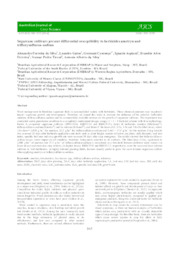Sugarcane cultivars present differential susceptibility to herbicides ametryn and trifloxysulfuron-sodium.
Sugarcane cultivars present differential susceptibility to herbicides ametryn and trifloxysulfuron-sodium.
Author(s): SILVA, A. F. da; GALON, L.; CONCENCO, G.; ASPIAZÚ, I.; FERREIRA, E. A.; TIRONI, S. P.; SILVA, A. A. da
Summary: Weed management in Brazilian sugarcane fields is accomplished mainly with herbicides. These chemical products may negatively impact sugarcane growth and development. Therefore, we aimed this study to evaluate the influence of the selective herbicides ametryn, trifloxysulfurom-sodium and its commercially available mixture on the growth of sugarcane cultivars. The experiment was conducted under greenhouse condition in a completely randomized design, using a 3×3×4 factorial scheme with four replications. Factor A comprised sugarcane cultivars (SP80-1816, RB855113 and RB867515); factor B herbicides ametryn (Metrimex®), trifloxysulfuron-sodium (Envoke®) and its mixture (Krismat®), and factor C the doses (0.0, 0.5x, 1.0x and 3.0x the label dose), where 1.0x dose= 2,000gha-1 for ametryn; 22.5gha-1 for trifloxysulfuron-sodium and 1, 463+37.0gha-1 for the mixture. Crop toxicity was assessed 28 days after herbicide application and traits such as plant height, number of leaves per plant, stalk diameter, leaf area index, specific leaf area and crop growth rate were assessed 80 days after crop emergence. The results showed that trifloxysulfuron-sodium causes lower impact on all variables; therefore, being more selective to all cultivars. The label dose (1.0x), equivalent to 2,000 gha-1 of ametryn and 22.5 gha-1 of trifloxysulfuron- sodium is considered as a threshold between deficient weed control (in lower doses) and excessive crop toxicity (in higher doses). RB867515 and RB855113, respectively, were the most and least tolerant cultivars to both herbicides. In highly infested planting fields, farmers usually prefer to grow the most tolerant sugarcane cultivar when applying ametryn or trifloxysulfurom sodium.
Publication year: 2014
Types of publication: Journal article
Unit: Embrapa Maize & Sorghum
Keywords: Cana de açúcar, Herbicida, Herbicides, Intoxicação, Saccharum, Trifloxysulfuron
Observation
Some of Embrapa's publications are published as ePub files. To read them, use or download one of the following free software options to your computer or mobile device. Android: Google Play Books; IOS: iBooks; Windows and Linux: Calibre.
Access other publications
Access the Agricultural Research Database (BDPA) to consult Embrapa's full library collection and records.
Visit Embrapa Bookstore to purchase books and other publications sold by Embrapa.

